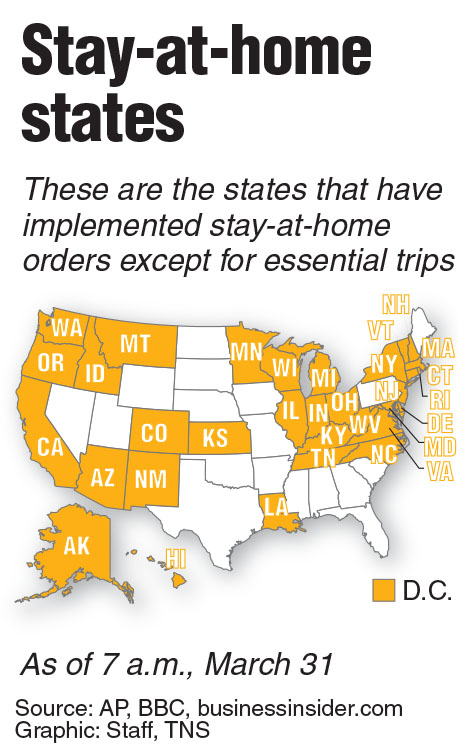By Hal Bernton
Tribune News Service
SEATTLE — Hospitalizations for patients with symptoms of COVID-19-like illnesses in Washington declined last week by more than 20%, a hopeful sign for the region and a nation gripped by the coronavirus pandemic.
The state Department of Health (DOH) survey, covering the seven-day period that ended Saturday, tallied 193 admissions of patients with symptoms of fever, cough and shortness of breath, down from 251 the previous week.
This also marks the end of a monthlong rise in these admissions, which dates back to the last week in February, when only 61 hospitalizations of COVID-19-like illness were counted in Washington state.
“It is a little bit of good news,” said Amy Reynolds, DOH spokeswoman.
The survey is not a complete snapshot of COVID-19 admissions since it does not include reporting from 16% of state’s hospital emergency rooms, and some patients who have the disease — but not all the symptoms — may not have been included in the tally.
The downturn in hospitalizations in Washington, once the epicenter of the U.S. coronavirus epidemic, comes as increasingly dire scenes unfold in other states — including New York, where some 9,500 people have been hospitalized and beleaguered doctors and nurses contend with a rapidly rising caseload of desperately sick patients.
Washington hospitals and health-care workers say they still have capacity to take care of more COVID-19 patients. But in recent weeks, they have been treating greater numbers of these patients who might require many days of intensive care.
And they still are very wary of what April will bring.
So, they have been conserving personal protective equipment (PPE) and freeing up space in preparation for a possible surge in numbers in the weeks ahead.
“We have seen an increase in volume of COVID-19 patients but fortunately at a slower rate than we anticipated, which is great,” Dr. Douglas Wood, chair of UW Medicine’s surgery department, said in an interview last week.
“We have enough surgical masks to do our job. But we have to anticipate tomorrow.”
Wood’s concerns are reflected in modeling by the UW’s Institute for Health Metrics and Evaluations, which forecasts a mid-April peak for COVID-19 hospitalizations in Washington state.
The modeling shows that a maximum of 650 to 750 people could be hospitalized just within the four hospitals of the UW Medicine Hospitals and Clinics, according to Lisa Brandenburg, president of that system.
The preparations for the pandemic also have caused widespread delays in scheduled surgeries for patients with a wide range of medical problems as well as cancellations of screenings.
And the Army is deploying 300 soldiers to staff a field hospital next to Seattle’s CenturyLink Field to treat some of these patients, and help free up space for those ill with COVID-19, whom Gov. Jay Inslee, in a March 19 letter to President Donald Trump, forecast would “be in crisis” by the end of March.
But there now are indications that social distancing — resulting in massive economic disruptions such as the shut down of bars and sit-down restaurants — is making a significant difference in slowing the spread of the coronavirus.
The Bellevue-based Institute for Disease Modeling analyzed Facebook data to track changes in mobility, and found people are spending less time in commercial areas and more in places zoned for single and multifamily homes.
In a second report that incorporates that modeling, the institute simulated how mobility changes have affected the spread of the coronavirus. In late February, the report estimates one infected person spread the disease on average to 2.7 other people.
By March 18, that transmission rate had dropped by about half, according to Dan Klein, a senior research manager at the institute.
Dr. Jeffrey Duchin, health officer for Public Health-Seattle & King County, joined Klein on Monday to brief reporters on these findings, and offered some optimism.
“We believe that we’re making a very positive impact on the course of this epidemic,” Duchin said. “That the measures we put in place appear to be working and … the number of deaths that we are seeing are likely to be significantly less than we would have experienced without these important measures.”
But Duchin cautioned that if “we don’t continue to comply with these measures … I can tell you that the outbreak will come roaring back, big time.”
And he cautioned it would months before people could go back to all their normal activities.
A key goal of social distancing is to keep hospitals from being overwhelmed by COVID-19 patients. So in the weeks ahead, hospitalizations will remain a crucial measure of the impact of the pandemic on the state’s health care system, and on the prospects for easing the restrictions.
Some states, such as California, are frequently updating these statistics and remaining capacity. But Washington has not yet come up with a way to report this information to the public.
Instead, Washington, on a weekly basis, at the request of the Seattle Times, has been releasing a broader measurement that looks at all patients hospitalized with the coronavirus symptoms. Those numbers are based on reports from 84% of the state’s hospital emergency departments.
In an interview last week, state health officer Dr. Kathy Lofy cautioned the numbers need to be taken with “a little grain of salt” because they are based on symptoms displayed by patients and might miss some that actually have the disease. And they include others whose testing might later determine they do not have the virus.
On Monday, Reynolds said a count of confirmed hospitalizations of patients with COVID-19 illness should be available by sometime next week on the state Department of Health website.
Overall, Washington has been more transparent and accurate than many others, according to a national group tracking COVID-19 state data. The COVID Tracking Project gives Washington an ‘A’ for its case reporting.

